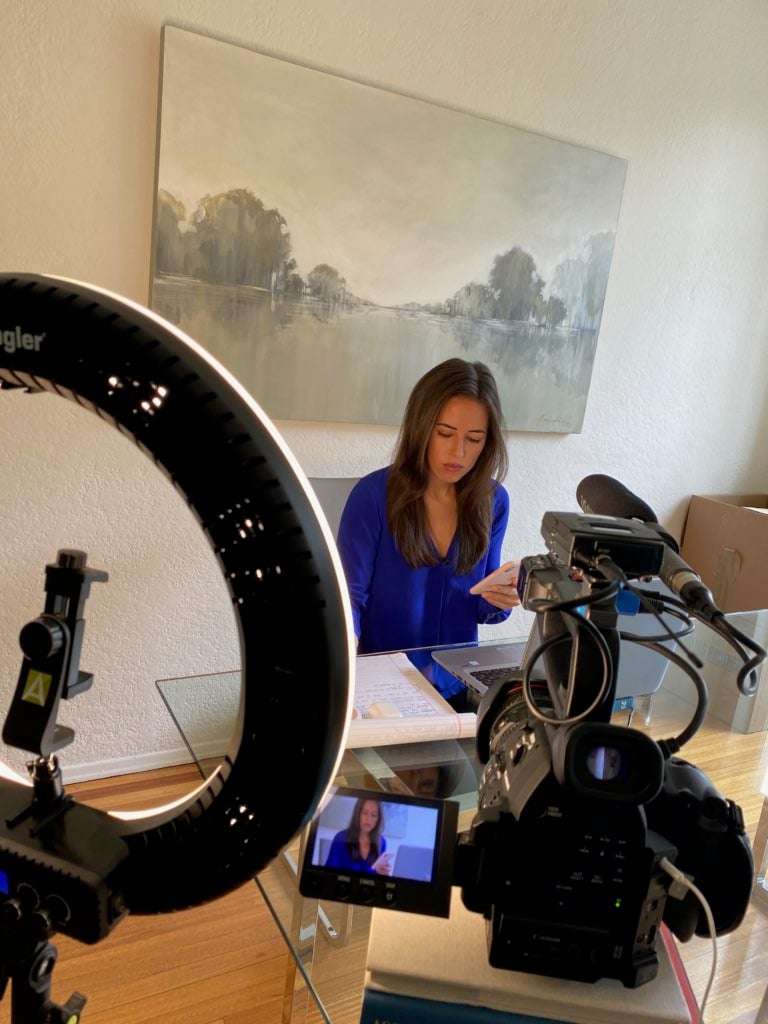
2020 Vision: Kaylee Hartung shares how COVID-19 has changed her
ABC News correspondent Kaylee Hartung sits in her dining room in West Hollywood—a painting by Baton Rouge artist and friend Lauren Barksdale Hill hanging right behind her—as she looks into the camera on her iPhone mounted on a tripod and waits for her cue to go live on “Good Morning America.” No professional hair and makeup. No camera technician. No blinking red light. Just an app that transports her across the country, live.
 “This experience for me—broadcasting from my living room—has helped me identify the best version of myself,” says Hartung. It’s a Thursday evening, and she’s relaying her story from the Los Angeles courtyard home she moved into in mid-February. “Sometimes, when the blinking red light goes on you feel like you have to present a certain way. Now, I just want to be the most authentic version of myself at this moment.”
“This experience for me—broadcasting from my living room—has helped me identify the best version of myself,” says Hartung. It’s a Thursday evening, and she’s relaying her story from the Los Angeles courtyard home she moved into in mid-February. “Sometimes, when the blinking red light goes on you feel like you have to present a certain way. Now, I just want to be the most authentic version of myself at this moment.”
Hartung’s authentic version of herself has been bought the hard way. Just six weeks ago, this Baton Rouge native was relegated to sitting on the curb outside Cedars Sinai hospital, waiting for the doctors and nurses to decide if she could be administered the COVID-19 test. They didn’t want her in the waiting room. Hartung had spent the previous week in Kirkland, Washington (outside Seattle) reporting on the initial outbreak of the virus at a nursing home. She thought she was safe: Hartung was healthy; she was young; she didn’t enter the nursing home; she washed her hands.
“At the time, no one could fathom that it could be such a silent killer,” says Hartung, who started having symptoms on March 11 and was ultimately given the test a few days later. “But the truth is, this was a worst-case scenario situation.”
Hartung was one of the first nationally recognizable names to go public with a positive COVID-19 diagnosis, and she did so because her symptoms were not exactly what was being projected at the time. She did not have shortness of breath or tightness in her chest. She never had a cough. Hartung did have a terrible headache, congestion and chills. But—had she not been reporting on the coronavirus situation in Seattle—she might have written it off as a cold and returned to work. Hartung wanted to tell the nation that her mild symptoms still produced a positive test result, and she was contagious. They could be too.
“I was slightly naïve at the beginning. We all were. But this has been eye opening,” says Hartung, who was suddenly thrown into isolation in a city she’d just moved to, in a home without groceries she’d just moved into. “However, I’ve never felt alone. I have been so overwhelmed with the outpouring of love and support I’ve felt. I’ve heard from friends and family on the opposite side of the country. I’ve never felt so loved.”
Hartung reported her COVID-19 test results on national television wearing a T-shirt—not the typical attire worn by a news reporter. But these days aren’t typical. She’s still been able to interview interesting people and tell compelling stories on a nation level, but it’s from the safety of her dining room. And now, healthy, she’s gone on walks around her neighborhood and has made one run to the grocery story. This week, she even ventured out to the Red Cross to donate plasma to help other victims of the virus.
“I hope that some good can come of this down time,” says Hartung, who has started putting her phone on Do Not Disturb mode for 45 minutes each day to unplug, to read a book, to journal. And she enjoys being more present and focused on what she is doing in the moment.
Whether it is organizing a closet, hanging a painting (she hung the Barksdale painting herself) or reporting live on TV. “I’ve become the most comfortable version of me. In a strange way, this has been a reset.











